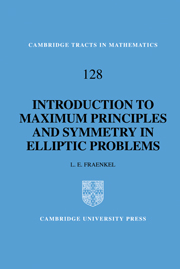Book contents
- Frontmatter
- Contents
- Preface
- 0 Some Notation, Terminology and Basic Calculus
- 1 Introduction
- 2 Some Maximum Principles for Elliptic Equations
- 3 Symmetry for a Non-linear Poisson Equation in a Symmetric Set Ω
- 4 Symmetry for the Non-linear Poisson Equation in ℝN
- 5 Monotonicity of Positive Solutions in a Bounded Set Ω
- Appendix A On the Newtonian Potential
- Appendix B Rudimentary Facts about Harmonic Functions and the Poisson Equation
- Appendix C Construction of the Primary Function of Siegel Type
- Appendix D On the Divergence Theorem and Related Matters
- Appendix E The Edge-Point Lemma
- Notes on Sources
- References
- Index
Appendix D - On the Divergence Theorem and Related Matters
Published online by Cambridge University Press: 05 February 2010
- Frontmatter
- Contents
- Preface
- 0 Some Notation, Terminology and Basic Calculus
- 1 Introduction
- 2 Some Maximum Principles for Elliptic Equations
- 3 Symmetry for a Non-linear Poisson Equation in a Symmetric Set Ω
- 4 Symmetry for the Non-linear Poisson Equation in ℝN
- 5 Monotonicity of Positive Solutions in a Bounded Set Ω
- Appendix A On the Newtonian Potential
- Appendix B Rudimentary Facts about Harmonic Functions and the Poisson Equation
- Appendix C Construction of the Primary Function of Siegel Type
- Appendix D On the Divergence Theorem and Related Matters
- Appendix E The Edge-Point Lemma
- Notes on Sources
- References
- Index
Summary
A first divergence theorem
Our task in this appendix is to extend the fundamental theorem of the calculus to functions defined on subsets of ℝN. If the result is to have a modest generality and to be of some use, then this task cannot be short and easy, for several reasons. First, it is not obvious how to pass from the merely local description of ∂Ω in Chapter 0, (viii), to the evaluation of integrals over ∂Ω as a whole; Definition D.I and Lemma D.2 are preparations for this step. Second, we must attend to the smoothness both of the function being integrated and of the boundary ∂Ω. Third, conditions that allow a straightforward proof of the divergence theorem (such as those in Theorem D.3) are often too restrictive for applications. Although we take only two primitive steps towards relaxing the conditions in Theorem D.3, those steps require a certain length if they are to be elementary and transparent.
Notation Throughout this appendix, ℝN is to have dimension N ≥ 2. The notation of Cartesian products will be taken beyond the definition of A × B in Chapter 0, (i); for example, (–β, β)N–1 denotes the cube Q′(0,β) described rather fully in Definition D.I, and {a} × [O,a]N–1 denotes a face of the cube (0, a)N, more precisely, the intersection of the hyperplane {x ∈ ℝN | x1 = a} and the closed cube [0,a]N.
- Type
- Chapter
- Information
- Publisher: Cambridge University PressPrint publication year: 2000



